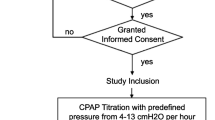Abstract
Purpose
Auto-CPAP devices (APAP) are controlled, e.g., by the respiratory flow and pressure to adjust the treatment pressure to the variable obstruction in sleep apnea syndromes. By obstruction of the upper airway during inspiration, a pressure difference between the lower airways and the mask can be measured. In case of an opening of the pharynx at the end of the obstruction, the pressure decreases immediately. This brief negative pressure, the so-called obstructive pressure peak (OPP) can be used to identify obstruction or open airways with the algorithm of an APAP device. Useless pressure increases, e.g., after central apneas without obstruction may be avoided. We therefore investigated the association of the OPP signal with respiratory events during APAP therapy.
Methods
In this pilot study, 13 patients with obstructive sleep apnea syndrome were evaluated. Attended automatic CPAP titration (SOMNObalance, Fa Weinmann Hamburg/Germany) was performed. The OPP signal was recorded synchronously in parallel with the polysomnographic data. If the OPP signal was within a time range of ±5 s of the resumption of normal breathing, it was assigned to the event.
Results
A total of 480 sleep-related breathing disorders events were studied. The most common were the mixed apneas associated with more than 90% of all cases with an OPP signal, followed by obstructive sleep apneas (66.7%) and central apneas (38%). The difference in OPP frequency distribution between central apneas and obstructive apneas was significant with p < 0.001.
Conclusions
The analysis of the pressure characteristics of APAP treatment with the registration of OPP allows a further differentiation in obstructed and not obstructed upper airways.


Similar content being viewed by others
References
Randerath W, Parys K, Lehmann D, Sanner B, Feldmeyer F, Rühle K-H (2000) Self-adjusting continuous positive airway pressure therapy based on the measurement of impedance. Respiration 67:272–279
Morgenthaler TI, Aurora RN, Brown T, Zak R, Alessi C, Boehlecke B, Chesson AL Jr, Friedman L, Kapur V, Maganti R, Owens J, Pancer J, Swick TJ, Standards of Practice Committee of the AASM, American Academy of Sleep Medicine (2008) Practice parameters for the use of autotitrating continuous positive airway pressure devices for titrating pressures and treating adult patients with obstructive sleep apnea syndrome: an update for 2007. An American Academy of Sleep Medicine report. Sleep 31:141–147
Massie CA, McArdle N, Hart RW, Schmidt-Nowara WW, Lankford A, Hudgel DW, Gordon N, Douglas NJ (2003) Comparison between automatic and fixed positive airway pressure therapy in the home. Am J Respir Crit Care Med 167:20–23
Randerath WJ, Schraeder O, Galetke W, Feldmeyer F, Rühle KH (2001) Autoadjusting CPAP therapy based on impedance efficacy, compliance and acceptance. Am J Respir Crit Care Med 163:652–657
Montserrat JM, Farré R, Navajas D (2001) New technologies to detect static and dynamic upper airway obstruction during sleep. Sleep Breath 5:193–206
Condos R, Norman RG, Krishnasamy I, Peduzzi N, Goldring RM, Rapoport DM (1994) Flow limitation as a noninvasive assessment of residual upper-airway resistance during continuous positive airway pressure therapy of obstructive sleep apnea. Am J Respir Crit Care Med 150:475–480
Ayappa I, Norman RG, Hosselet JJ, Gruenke RA, Walsleben JA, Rapoport DM (1998) Relative occurrence of flow limitation and snoring during continuous positive airway pressure titration. Chest 114:685–690
Morgenstern C, Schwaibold M, Randerath WJ, Bolz A, Jané R (2010) An invasive and a noninvasive approach for the automatic differentiation of obstructive and central hypopneas. IEEE Trans Biomed Eng 57(8):1927–1936
Farré R, Rigau J, Montserrat JM, Ballester E, Navajas D (2001) Evaluation of a simplified oscillation technique for assessing airway obstruction in sleep apnoea. Eur Respir J 17:456–461
Pilz K, Thalhofer S, Meissner P, Dorow P (2000) Improvement of CPAP therapy by a self-adjusting system. Sleep Breath 4:169–172
Rühle KH, Schlenker E, Randerath W (1997) Upper airway resistance syndrome. Respiration 64(Suppl 1):29–34
Rechtschaffen A, Kales A (1968) A manual of standardized terminology, techniques and scoring system for sleep stages of human subjects. Brain Information Service/ Brain Research Institute, University of California, Los Angeles
ASDA Task Force (1992) EEG arousals; scoring rules and examples. Sleep 15:173–184
Iber C, Ancoli-Israel S, Chesson A, Quan S, American Academy of Sleep Medicine (2007) The AASM manual for the scoring of sleep and associated events: rules, terminology and technical specifications, 1st edn. American Academy of Sleep Medicine, Westchester
Badr MS, Toiber F, Skatrud JB, Dempsey J (1995) Pharyngeal narrowing/occlusion during central sleep apnea. J Appl Physiol 78:1806–1815
Badia JR, Farré R, Montserrat JM, Ballester E, Hernandez L, Rotger M, Rodriguez-Roisin R, Navajas D (1998) Forced oscillation technique for the evaluation of severe sleep apnoea/hypopnoea syndrome: a pilot study. Eur Respir J 11:1128–1134
Galetke W, Stieglitz S, Anduleit N, Kenter M, Kühnel J, Osagie-Paech R, Richter K, Randerath W (2009) Evaluation of a new automatic CPAP algorithm in the treatment of obstructive sleep apnoea syndrome. Pneumologie 63:261–265
Rigau J, Montserrat JM, Wöhrle H, Plattner D, Schwaibold M, Navajas D, Farré R (2006) Bench model to simulate upper airway obstruction for analyzing automatic continuous positive airway pressure devices. Chest 130:350–361
Farré R, Montserrat JM, Rigau J, Trepat X, Pinto P, Navajas D (2002) Response of automatic continuous positive airway pressure devices to different sleep breathing patterns: a bench study. Am J Respir Crit Care Med 166:469–473
Rühle KH, Karweina D, Domanski U, Nilius G (2009) Characteristics of auto-CPAP devices during the simulation of sleep-related breathing flow patterns. Pneumologie 63:390–398
Conflicts of interest
K.H. Rühle and G. Nilius received funding from Weinmann, Fisher & Paykel Healthcare, Heinen and Löwenstein, ResMed, and TNI. This money went to scientific projects of the clinic, including methodology in this work.
Author information
Authors and Affiliations
Corresponding author
Rights and permissions
About this article
Cite this article
Ruhle, K.H., Domanski, U. & Nilius, G. Obstructive pressure peak: a new method for differentiation of obstructive and central apneas under auto-CPAP therapy. Sleep Breath 17, 111–115 (2013). https://doi.org/10.1007/s11325-012-0657-7
Received:
Revised:
Accepted:
Published:
Issue Date:
DOI: https://doi.org/10.1007/s11325-012-0657-7




